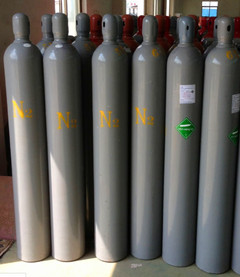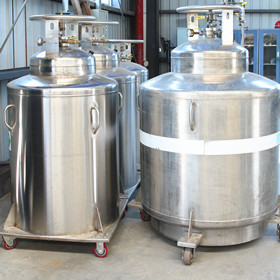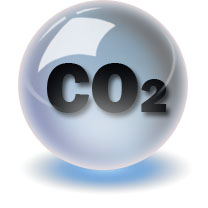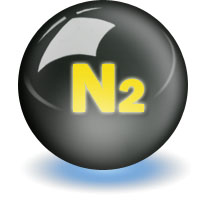歡迎蒞臨廣州譜源氣體有限公司
聯(lián)系粵佳
廣州市譜源氣體有限公司


安全知識--Gaseous Nitrogen氮氣
2008-8-23 11:49:00 [點擊下載:2008823112921183.doc]
Nitrogen makes up the major portion of the atmosphere (78.03% by volume, 75.5% by weight). Gaseous nitrogen is inert, colorless, odorless, tasteless, nontoxic, non corrosive, and nonflammable. Nitrogen is inert and will not support combustion; however, it is not life supporting.
氮構(gòu)成了大氣的大部分(體積比78.03,重量比75.5%)。氣態(tài)氮是不活潑的,無色,無嗅,無味,無毒,無腐蝕性,不可燃。氮是不活潑的,不支持燃燒;但是它不是維持生命的必要元素。
Nitrogen is inert except when heated to very high temperatures, where it combines with some of the more active metals, such as lithium and magnesium, to form nitrides. It will also combine with oxygen to form oxides of nitrogen and when combined with hydrogen in the presence of catalysts, will form ammonia.
一般情況下,氮是不活潑的的。當加熱到非常高的溫度時它會同更加活潑的金屬,如鋰和鎂反應(yīng)生成氮化物。它還會同氧反應(yīng)生成氮的氧化物,而且當在有催化劑存在時它會同氫反應(yīng)生成氨。
Since gaseous nitrogen is non corrosive, special materials of construction are not required. Vessels and piping should be designed to the American Society of Mechanical Engineers (ASME) standards or Department of Transportation (DOT) codes for the pressure and temperatures involved.
由于氣態(tài)氮無腐蝕性,不需要特殊的建材。容器和管道系統(tǒng)要根據(jù)相關(guān)的壓力和溫度按照美國機械工程師協(xié)會(ASME)的標準或交通部(DOT)的規(guī)定來設(shè)計。
Nitrogen may be compressed into cylinders using water- or oil-lubricated compressors or by dry compression systems.
可以使用水或油潤滑的壓縮機或干壓縮系統(tǒng)把氮壓縮進鋼瓶。
上一篇:幾種氣體滅火劑的介紹
- 核磁共振等行業(yè)可能受氦氣短缺影響成本上升2019-06-05
- 環(huán)境監(jiān)測中的光譜學(xué)技術(shù)進展2018-12-13
- 氫氣已被多國列為食品添加劑2018-11-27
- 塞拉尼斯將收購林德在得克薩斯氫氣和一氧化碳工..2018-11-24
- 甲醇市場持續(xù)下跌2018-11-22
- 普萊克斯在美國新建液氫工廠2018-11-08
- 大連化物所實現(xiàn)二氧化碳直接加氫制取芳烴2018-11-07
- 氦氧混合潛水作業(yè)成功打撈重慶萬州墜江公交車2018-11-03
- 馬鋼氣體成功研制出高純氮氣和高純氬氣2018-10-30
- 為什么說氦氣是天然氣體中被忽視的“黃金”2020-01-10
廣州市譜源氣體有限公司 粵ICP備08114730號
地址:廣州市增城新塘西洲大王崗工業(yè)區(qū)
全國熱線電話:19876107228
公司電話:19876107228
公司傳真:020-82797482
聯(lián)系郵箱:[email protected]
地址:廣州市增城新塘西洲大王崗工業(yè)區(qū)
全國熱線電話:19876107228
公司電話:19876107228
公司傳真:020-82797482
聯(lián)系郵箱:[email protected]







